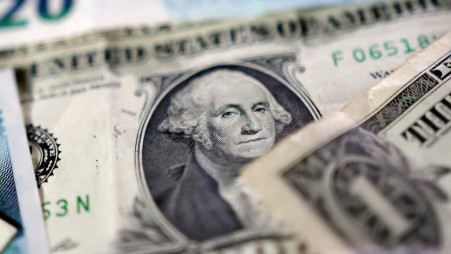Traders were also wary of US officials potentially angling for a weaker dollar at Group of Seven finance minister meetings currently underway in Canada
US dollar banknotes are seen in this illustration taken May 4, 2025. Photo: REUTERS/Dado Ruvic/Illustration
“>

US dollar banknotes are seen in this illustration taken May 4, 2025. Photo: REUTERS/Dado Ruvic/Illustration
Highlights:
- Trump failed to convince Republican holdouts who could block bill
- Bessent to talk currencies with Japanese counterpart on G7 sidelines
- “Sell America” investment theme continues to weigh on dollar
The US dollar fell on Wednesday, extending a two-day slide against major peers, as President Donald Trump failed to convince Republican holdouts to back his sweeping tax bill.
Traders were also wary of US officials potentially angling for a weaker dollar at Group of Seven finance minister meetings currently underway in Canada.
Developments in Trump’s global tariff war, which have swung currencies wildly in recent months, have slowed considerably this week, even as the clock ticks down to the end of 90-day tariff respites for US trade partners in the absence of new trade deals.
While markets remain optimistic that the White House is eager to get trade flowing again on a sustained basis, talks with close allies Tokyo and Seoul appear to have lost momentum.
All this has combined to keep the dollar under pressure and US Treasury yields rising, as the “sell America” theme continues to inform investment decisions, if in a less dramatic fashion than earlier this month.
“We do not consider the USD – and US assets generally – are at the start of a ‘death spiral’,” Commonwealth Bank of Australia analysts wrote in a note.
“However, we forecast the USD to re‑weaken in 2026 once the tariff uncertainty fades and lower interest rates support a recovery in the world economy,” they said. “Additionally, we expect large money managers to allocate less capital to USD assets over time.”
A Moody’s downgrade of the US sovereign debt rating on Friday may have only had a limited impact on markets, but it has added to the narrative of less faith in US assets as safe havens.
Trump’s tax bill would add $3 trillion to $5 trillion to the country’s debt, according to nonpartisan analysts. Ballooning fiscal debt, trade frictions, and weakened confidence have weighed on US assets.
“Tariff rates are now lower, but not low, and the same can be said about recession risks in the US,” Goldman Sachs analysts wrote in a research note.
“But as recession risks have compressed, risks from higher rates are growing,” they said. “The US still faces the worst growth-inflation mix of the major economies, and as the fiscal bill makes its way through Congress, eroding US exceptionalism is proving – literally – costly at a time of large funding needs.”
“This leaves wider paths to a weaker dollar and a steeper US Treasury curve.”
The dollar declined 0.55% to 143.715 yen as of 0520 GMT, and slipped 0.67% to 0.8222 Swiss franc .
Japanese Finance Minister Katsunobu Kato said ahead of an expected meeting with US Treasury Secretary Scott Bessent that talks on exchange rates would be based on their shared view that excessive currency volatility is undesirable.
The euro rose 0.42% to $1.1332, while sterling added 0.3% to $1.34315.
UK consumer inflation figures are the only data point of note over the course of the global day.
The dollar index , which measures the US currency against those four peers and two other rivals, slumped 0.38% to 99.59, extending a 1.3% two-day decline.
Federal Reserve officials on Tuesday also doubled down on their concerns about the impact of the Trump administration’s trade policies on the economy. The collective message was that the Fed is firmly in wait-and-see mode.
“There remains a high degree of confidence, possibly complacency, that agreements will be struck, tariffs will come down, and the pauses with countries like China will turn into permanent policy,” said Kyle Rodda, senior financial market analyst at Capital.com.
“However, for the momentum to continue, fresh news is required for the markets to extend their climb up the proverbial wall of worry.”






